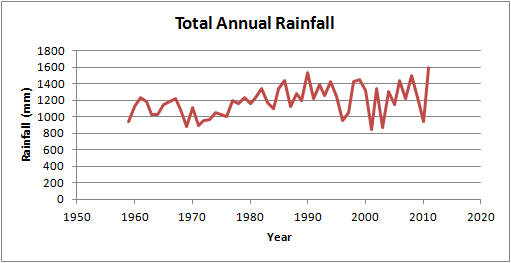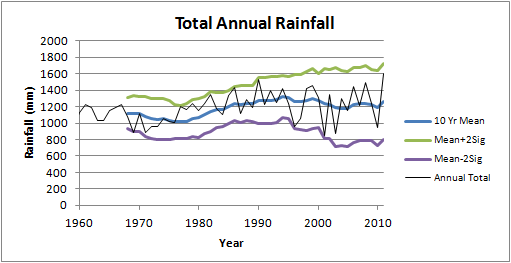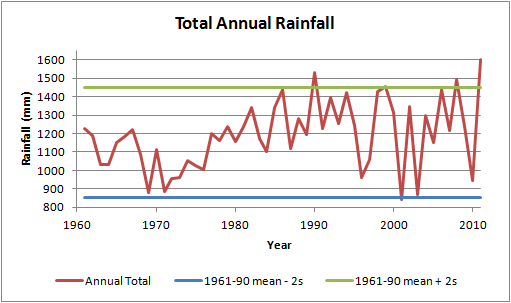Here Comes the Rain - Part 1
Summer 2012 may be remembered for the Olympic Games. Or it may be remembered for the rain. From doom laden predictions of the worst drought for a generation in the southern half of Britain with disastrous consequences for farmers in the spring to torrential rain, floods and, yes, disastrous consequences for farmers in the summer.
The burning question is whether this is just the natural variability of weather or whether underlying climate change has a hand in driving these weather systems. To investigate this question, I have studied some local weather records. My statistical skills are about High School level: mean and standard deviation of a normal distribution.
Data for Glasgow Airport from 1959 to 2012 was obtained from the Meteorological Office website but the 2012 data was discarded as it is only provisional and represents an incomplete year. The data included monthly rainfall, sunshine and maximum and minimum temperatures and the focus of this study was the rainfall data.
Annual rainfall figures are plotted below as a time series. The y-axis (rainfall) is drawn from zero to give a clearer picture of the relative changes; some graphs cut off the bottom which can visually exaggerate trends. Without performing any statistical analysis, the first impression is that annual rainfall has increased from the early 1970s to the mid 1990s before increasing again from around 2000 to the present time. The variability from year to year also appears to be greater in the more recent results, especially in the 2000s.


Variability of results is commonly measured using standard deviation of the measurements and from this the probability of outlying results can be assessed. Ninety five percent of measurements would be expected within a range of plus or minus 1.98 times the standard deviation from the mean. This has been rounded to two times the standard deviation and plotted on the graph above (Mean+2Sigma. Mean-2Sigma). The standard deviation has been applied in a similar way to the rolling average by calculating it over ten annual measurements then plotting against the last year of the ten. The original observation regarding increasing variability is supported by these plots. The graph below plots the standard deviation as a percentage of the mean to give a clearer picture of the scale of changing variability. There is a significant and rapid change from around 10% until 1995 before jumping to almost 20% by 2003.

The final plot,below, shows the original data plotted alongside the 2 sigma values taken from the full data set from 1961 to 1990, a thirty year base line which the Meteorological Office are using to measure climate changes against. The mean over this period was 1150mm. Over the past decade, the upper confidence limit which is expected to be exceeded in 2.5% of the observations (once in forty years) has been exceeded twice and the lower confidence limit has been exceeded once. This reinforces the increasing variability in rainfall over recent years.

The conclusion from this analysis is that annual rainfall in Paisley has increased from a low point in the early to mid 1970s to a high in the late 1980s and early 1990s. It has fallen slightly since then but the average from 2002-2011 is still almost 10% higher than the long term average from 1961 to 1990. Of perhaps more significance is the increased variability resulting from a trend for greater extremes of very dry and very wet years.These observations tend to support reports from global climate models that there is likely to be increased variability in weather patterns as a result of climate change.
If this trend continues it could have repercussions for managing water supplies and hydro electric generation on one side and floods and land slides on the other. Flooding are influenced more by individual storms or a sequence of storms more than by the total annual rainfall , however higher annual rainfall will tend to make the ground more waterlogged resulting in less water being absorbed by the ground during intense storms and hence greater chance of flooding.
In Part 2 of this article, monthly rainfall data will be examined to assess whether the seasons are changing.
Related Links:
Meteorological Office
Related Posts:
Here Comes the Rain, Part 2
Rest and be Thankful, but not about Climate Change
Another Landslide
The burning question is whether this is just the natural variability of weather or whether underlying climate change has a hand in driving these weather systems. To investigate this question, I have studied some local weather records. My statistical skills are about High School level: mean and standard deviation of a normal distribution.
Data for Glasgow Airport from 1959 to 2012 was obtained from the Meteorological Office website but the 2012 data was discarded as it is only provisional and represents an incomplete year. The data included monthly rainfall, sunshine and maximum and minimum temperatures and the focus of this study was the rainfall data.
Annual rainfall figures are plotted below as a time series. The y-axis (rainfall) is drawn from zero to give a clearer picture of the relative changes; some graphs cut off the bottom which can visually exaggerate trends. Without performing any statistical analysis, the first impression is that annual rainfall has increased from the early 1970s to the mid 1990s before increasing again from around 2000 to the present time. The variability from year to year also appears to be greater in the more recent results, especially in the 2000s.
The next graph presents the same data but also has a rolling average overlain. The rolling average is the average (mean) of the year and the nine preceding years. Each data point on this line is therefore a ten year average and this helps to smooth out the effects of a single particularly wet or dry years and gives a better impression of longer term trends. The choice if ten years as an averaging period is arbitrary but useful if comparing one decade with another. From the rolling average the upward trend from the early to mid 1970s until the late 1990s is quite clear although the 2000s have shown a steady decline which is less obvious from the individual results. The results do show that in the decade 2000-2009 there was 15% more rainfall than 1970-1979.
The final plot,below, shows the original data plotted alongside the 2 sigma values taken from the full data set from 1961 to 1990, a thirty year base line which the Meteorological Office are using to measure climate changes against. The mean over this period was 1150mm. Over the past decade, the upper confidence limit which is expected to be exceeded in 2.5% of the observations (once in forty years) has been exceeded twice and the lower confidence limit has been exceeded once. This reinforces the increasing variability in rainfall over recent years.
The conclusion from this analysis is that annual rainfall in Paisley has increased from a low point in the early to mid 1970s to a high in the late 1980s and early 1990s. It has fallen slightly since then but the average from 2002-2011 is still almost 10% higher than the long term average from 1961 to 1990. Of perhaps more significance is the increased variability resulting from a trend for greater extremes of very dry and very wet years.These observations tend to support reports from global climate models that there is likely to be increased variability in weather patterns as a result of climate change.
If this trend continues it could have repercussions for managing water supplies and hydro electric generation on one side and floods and land slides on the other. Flooding are influenced more by individual storms or a sequence of storms more than by the total annual rainfall , however higher annual rainfall will tend to make the ground more waterlogged resulting in less water being absorbed by the ground during intense storms and hence greater chance of flooding.
In Part 2 of this article, monthly rainfall data will be examined to assess whether the seasons are changing.
Related Links:
Meteorological Office
Related Posts:
Here Comes the Rain, Part 2
Rest and be Thankful, but not about Climate Change
Another Landslide
This is really interesting. I watched Carbon Nation the other day and learned a little more about why we're seeing more rain and less snow. It has a lot to do with our practices and climate change. Unfortunately, it appears that it'll get worse if the world doesn't make some changes ... and that will take government intervention. I'm curious about your data for the seasons ... I'm guessing that they have changed with basically two seasons emerging ... wet and dry. In my area, we haven't seen 4 distinct seasons in awhile. Thanks for some eye-opening information.
ReplyDeleteThis comment has been removed by the author.
ReplyDeleteFinally, found you! I must have searched for three hours trying to remember where I did see that first graph. The one that made me think that night it would be cool to plot rain variability (sort of like a climate VIX index which measures volatility in stock prices) - and here you are with the standard deviation graph!
ReplyDeleteMy dear EcoWarrior, where did you find the raw data? and does any of it go back to before the 1880s, this being Great Britain and all? Perhaps one would see the rain equivalent of that hockey-stick effect in temperature series? I found the Met Office data but that looks like it's been averaged over too large areas to really show the variations like in your data. Maybe I wasn't digging in the right place.
CelloMom,
DeleteI obtained the raw data from the Met Office (http://www.metoffice.gov.uk/climate/uk/stationdata/) which has data from specific stations. The station that I used is located at Glasgow Airport and goes back only as far as 1959. I'm a bit nervous of conclusions drawn on such a relatively short timescale as there is a period with lower volatility and one with higher volatility, which could be part of long term multi-decadal cycles, although the trend corresponds with climate model predictions.
If you click on the stations on the met office site, you will find that some of them go back a lot longer: Armagh in Northern Ireland has rainfall from 1853 and temperatures from 1865, Oxford has rainfall and temperature data back to 1853 and Durham to 1880.
Great, Thank you! I've been looking at the Oxford data; on average, it only gets half the rain that Glasgow gets - but we knew that :-)
DeleteBut it also seems to me that the volatility of rain fall in the late 1800s seems to be comparable to that of the past twenty years. Just from looking at the chart. Which is not good enough. But I don't have the wherewithal to do the kind of statistical analysis you did on the Glasgow data. Could you be convinced to do the same for Oxford?
By the way, I do agree with your conclusion: it is exactly the unpredictability of the local weather all over the planet that poses such a serious threat to our food supply.